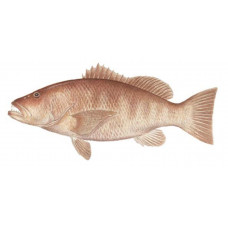Latin name
Lutjanus cyanopterus
Other names
Cuban snapper; Spanish: cubera, guasinuco, pargo cabalo, pargo cubera.
Identification
The body is elongated, short. Mouth with large lips. Both jaws have fang-like teeth. The teeth on the caterpillar are arranged in a crescent shape. The soft parts of the dorsal and anal fins have scales. The anal fin is rounded. Fish have connected dorsal fins consisting of 10 spines and 14 rays, and pectoral fins that do not reach the beginning of the anal fin. The head, body, and fins are silvery or steel gray to dark brown, sometimes with a reddish tint. The top of the body is darker than the bottom, sometimes with a violet sheen. Most young fish and some adults have irregular pale stripes on the upper part of the body. The fish have dark red eyes and thick lips.
Distribution
In the western Atlantic Ocean, they occur from Florida and Cuba southward to the mouth of the Amazon in Brazil. They are very rare north of Florida to New Jersey, rare in the Gulf of Mexico, and generally sparse throughout most of their range.
Habitat
Adult fish live offshore on shipwrecks, reefs, ledges, and rocky bottoms. Juveniles sometimes enter freshwater or live in mangroves and grassy areas. The fish are solitary and usually found in depths of 60 feet or deeper.
Size
Snapper usually weigh up to 40 pounds, but can weigh over 100 pounds and reach lengths of 4 or more. The world record for all-tackle fishing is held by a Louisiana fish weighing 121 pounds, 8 ounces.
Life history and Behavior
In the Florida Keys, fish spawn in late summer and early fall during the full moon.
Food and feeding habits
It feeds mainly on fish, as well as crustaceans (shrimp and crabs).
Reproduction
No information
| Classification | |
| Phylum | Chordata |
| Class | Actinopterygii |
| Squad | Perciformes |
| Family | Lutjanidae |
| Genus | Lutjanus |
| Species | L. cyanopterus |
| Features | |
| Conservation status | Vulnerable |
| Habitat | Littoral |
| Life span, years | No information |
| Maximum body weight, kg | 57 |
| Maximum length, cm | 160 |
| Sailing speed, m/s | No information |
| Threat to people | Edible |
| Way of eating | Predator |




